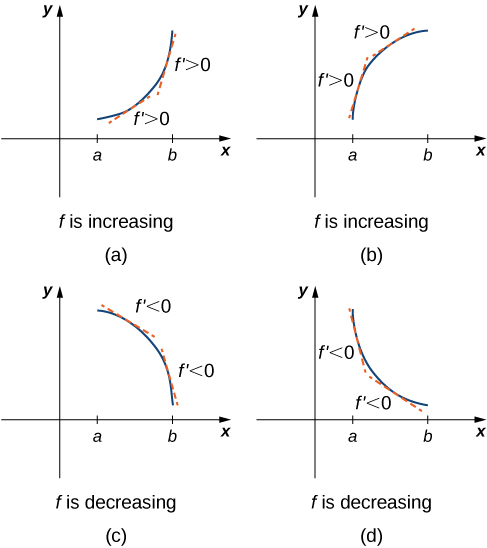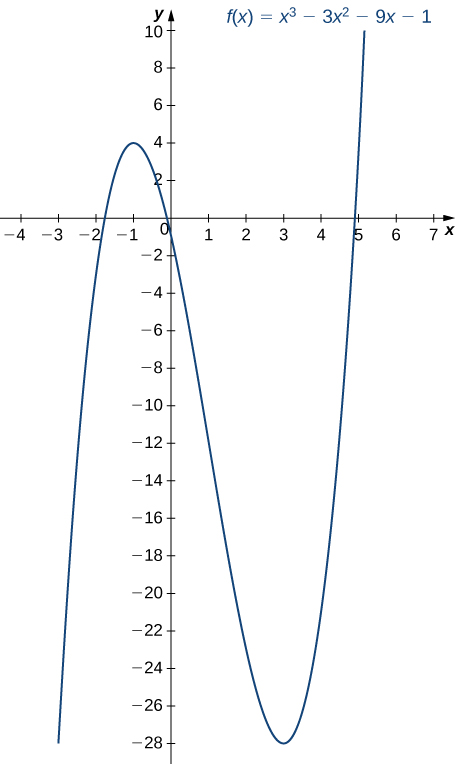- Use the first derivative to determine where a function is going up or down, and identify points that might be local highs or lows
- Apply the second derivative to find out where a function curves upward or downward and locate points where this curvature changes
- Use the second derivative test to determine if a point on a graph is the highest or lowest within specific sections
The First Derivative Test
Corollary 3 of the Mean Value Theorem showed that if the derivative of a function is positive over an interval [latex]I[/latex] then the function is increasing over [latex]I[/latex]. On the other hand, if the derivative of the function is negative over an interval [latex]I[/latex], then the function is decreasing over [latex]I[/latex] as shown in the following figure.

A continuous function [latex]f[/latex] has a local maximum at point [latex]c[/latex] if and only if [latex]f[/latex] switches from increasing to decreasing at point [latex]c[/latex]. Similarly, [latex]f[/latex] has a local minimum at [latex]c[/latex] if and only if [latex]f[/latex] switches from decreasing to increasing at [latex]c[/latex].
If [latex]f[/latex] is a continuous function over an interval [latex]I[/latex] containing [latex]c[/latex] and differentiable over [latex]I[/latex], except possibly at [latex]c[/latex], the only way [latex]f[/latex] can switch from increasing to decreasing (or vice versa) at point [latex]c[/latex] is if [latex]{f}^{\prime }[/latex] changes sign as [latex]x[/latex] increases through [latex]c.[/latex]
If [latex]f[/latex] is differentiable at [latex]c,[/latex] the only way that [latex]{f}^{\prime }.[/latex] can change sign as [latex]x[/latex] increases through [latex]c[/latex] is if [latex]f^{\prime}(c)=0[/latex].
Therefore, for a function [latex]f[/latex] that is continuous over an interval [latex]I[/latex] containing [latex]c[/latex] and differentiable over [latex]I[/latex], except possibly at [latex]c[/latex], the only way [latex]f[/latex] can switch from increasing to decreasing (or vice versa) is if [latex]f^{\prime}(c)=0[/latex] or [latex]f^{\prime}(c)[/latex] is undefined.
Consequently, to locate local extrema for a function [latex]f[/latex], we look for points [latex]c[/latex] in the domain of [latex]f[/latex] such that [latex]f^{\prime}(c)=0[/latex] or [latex]f^{\prime}(c)[/latex] is undefined. Recall that such points are called critical points of [latex]f[/latex]. Note that [latex]f[/latex] need not have a local extrema at a critical point. The critical points are candidates for local extrema only.
In Figure 2, we show that if a continuous function [latex]f[/latex] has a local extremum, it must occur at a critical point, but a function may not have a local extremum at a critical point. We show that if [latex]f[/latex] has a local extremum at a critical point, then the sign of [latex]f^{\prime}[/latex] switches as [latex]x[/latex] increases through that point.

Using Figure 2, we summarize the main results regarding local extrema.
- If a continuous function [latex]f[/latex] has a local extremum, it must occur at a critical point [latex]c[/latex].
- The function has a local extremum at the critical point [latex]c[/latex] if and only if the derivative [latex]f^{\prime}[/latex] switches sign as [latex]x[/latex] increases through [latex]c[/latex].
- Therefore, to test whether a function has a local extremum at a critical point [latex]c[/latex], we must determine the sign of [latex]f^{\prime}(x)[/latex] to the left and right of [latex]c[/latex].
This result is known as the first derivative test.
first derivative test
Suppose that [latex]f[/latex] is a continuous function over an interval [latex]I[/latex] containing a critical point [latex]c[/latex]. If [latex]f[/latex] is differentiable over [latex]I[/latex], except possibly at point [latex]c[/latex], then [latex]f(c)[/latex] satisfies one of the following descriptions:
- If [latex]f^{\prime}[/latex] changes sign from positive when [latex]x < c[/latex] to negative when [latex]x > c[/latex], then [latex]f(c)[/latex] is a local maximum of [latex]f[/latex].
- If [latex]f^{\prime}[/latex] changes sign from negative when [latex]x < c[/latex] to positive when [latex]x >[/latex], then [latex]f(c)[/latex] is a local minimum of [latex]f[/latex].
- If [latex]f^{\prime}[/latex] has the same sign for [latex]x < c[/latex] and [latex]x>c[/latex], then [latex]f(c)[/latex] is neither a local maximum nor a local minimum of [latex]f[/latex].
We can summarize the first derivative test as a strategy for locating local extrema.
How to: Use the First Derivative Test
To determine local extrema of a function [latex]f(x)[/latex] that is continuous on an interval [latex][a,b][/latex], follow these steps:
-
- Identify Critical Points: Find all critical points of [latex]f(x)[/latex] within the interval and note these points along with the endpoints [latex]a[/latex] and [latex]b[/latex].
- Divide the Interval: Segment the interval [latex][a,b][/latex] using the critical points as boundaries, creating smaller subintervals.
- Analyze the Sign of [latex]f′(x)[/latex]: Evaluate the derivative [latex]f′(x)[/latex] within each subinterval. A change in the sign of [latex]f′(x)[/latex] across a critical point indicates a local extremum at that point:
- If [latex]f′(x)[/latex] changes from positive to negative, [latex]f(x)[/latex] has a local maximum at the critical point.
- If [latex]f′(x)[/latex] changes from negative to positive, [latex]f(x)[/latex] has a local minimum at the critical point.
- If [latex]f′(x)[/latex] does not change sign, [latex]f(x)[/latex] does not have a local extremum at that critical point.
- Compare Values: Evaluate [latex]f(x)[/latex] at the critical points and endpoints to identify the absolute maximum and minimum over the interval.
Recall that when talking about local extrema, the value of the extremum is the [latex]y[/latex] value and the location of the extremum is the [latex]x[/latex] value.
Now let’s look at how to use this strategy to locate all local extrema for particular functions.
Use the first derivative test to find the location of all local extrema for [latex]f(x)=x^3-3x^2-9x-1[/latex]. Use a graphing utility to confirm your results.
Use the first derivative test to find the location of all local extrema for [latex]f(x)=5x^{\frac{1}{3}}-x^{\frac{5}{3}}[/latex]. Use a graphing utility to confirm your results.

